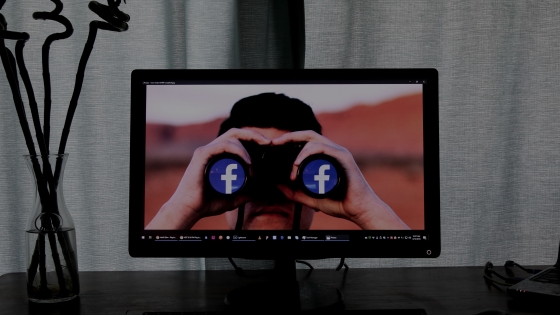Facebook recently announced that, starting July 31st, Facebook Business Pages can no longer send broadcast messages to their subscribers…sort of.
(Keep reading to find out what they actually said and what it means).
This caused a lot of chatbot marketers to freak out.
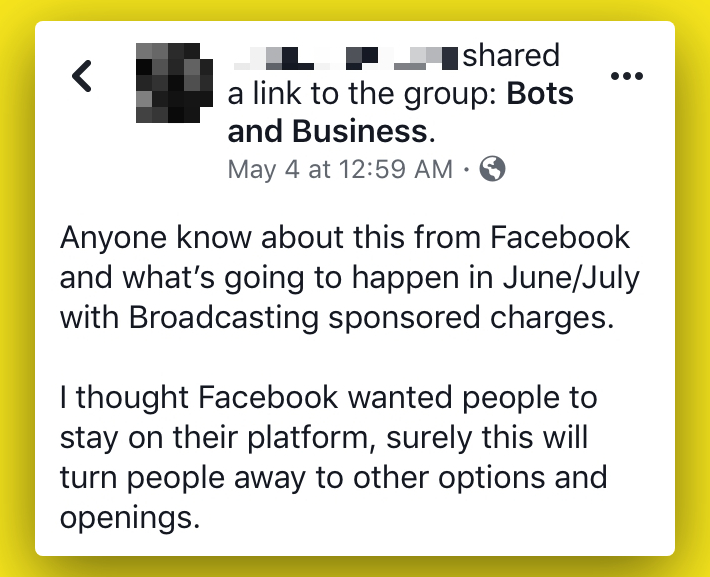
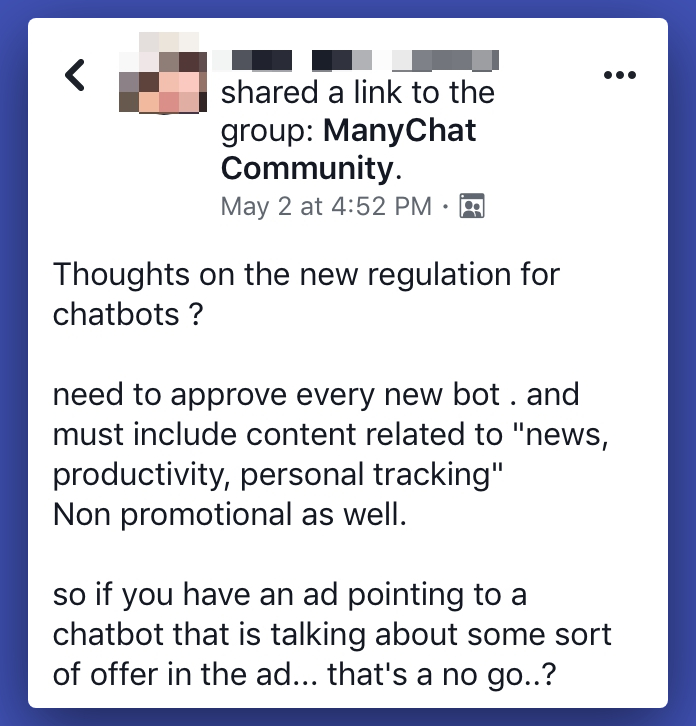
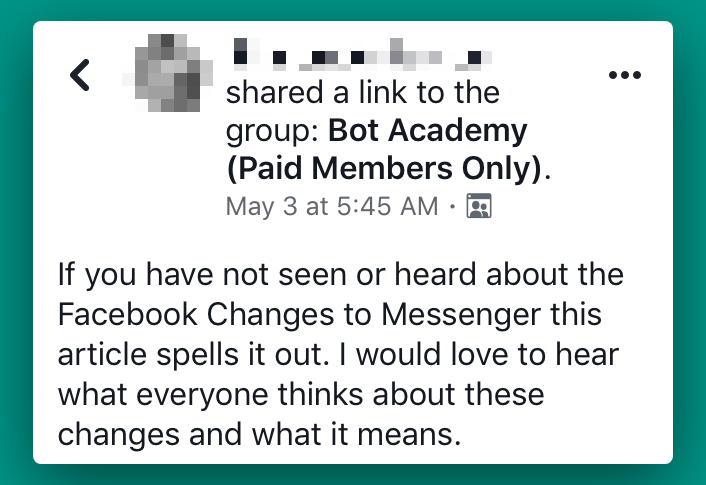
We also got a lot of questions about this from potential Bot Academy students when we opened enrollment last week.
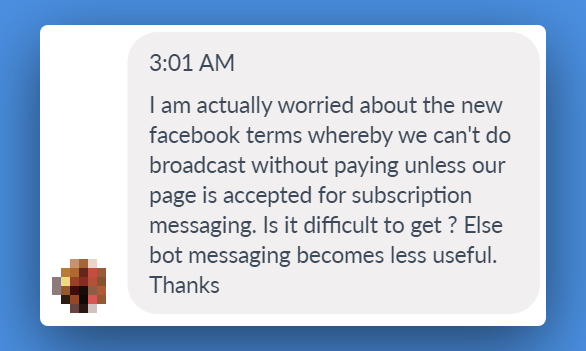
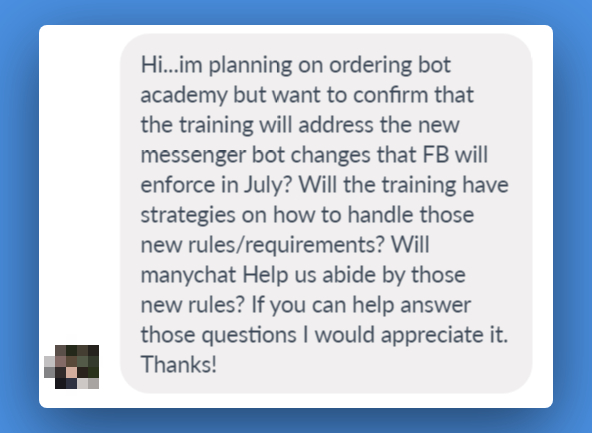

Here’s the deal. Bot Academy’s founder, Andrew Warner, has access to a lot of insider information so we’ve been preparing for this for a while. Here’s how we knew this was coming:
- As an investor in multiple chatbot companies, Andrew has been in the loop about how they were preparing for the policy update.
- Andrew hosts a popular startup podcast, Mixergy. His fans slip him inside info, often.
- When Andrew speaks at events, he sits down with people in private to get inside info.
Not only did we know about it, check out this slide from Andrew’s presentation at Social Media Marketing World 2019 where he announced this was coming…long before Facebook officially announced it.

So let’s look at how this change affects chatbot marketers, and how you can still use chatbots successfully to engage and convert your audience.
What the Policy Actually Says
First, let’s clear up the confusion around what you can and cannot do once this policy goes into effect.
You can no longer send out broadcast chat messages whenever you want to, unless you are approved.
This approval was previously at the app-level, so if you were using an approved app (ManyChat, Chatfuel, ShopMessage, etc.) you were approved for subscription messages.
Now, each Facebook Page needs permission to send subscribers regular content via Messenger. So Facebook.com/Nike or Facebook.com/BotAcademy each need their own permission.
What you should do: ask to get approved.
We wrote an entire post in January explaining how to do that. We’ve seen people ask several times before getting a yes, so if you’re denied initially, keep trying.
WARNING: Even if you are approved, you canNOT send promotional messages for free. But you can broadcast non-promotional messages to your chatlist any time you want, or you can pay to send sponsored promotional messages.
What If You Don’t Get Approved? It’s Fine.
You can still market using the chatbot approach we’ve always recommended.
If you’ve ever been to our intro webinar, you know we’ve always fought against the stupidity of just firing off broadcast messages whenever you want. No one likes getting “blasts” so you shouldn’t be sending them.
The greatest value in chatbots has always been in driving meaningful interactions with real users. That’s more true now than ever.
5 Ways to Succeed with Chatbots After the Update
Here are some meaningful interactions that you should have after the update.
1. Use Sequences
When users engage with a brand on Messenger, they are raising their hand, saying “I want to hear from you!”
This is an opportunity to provide value and build a relationship, and the best way to do that is through teaching. Understand your subscribers’ goals and use a sequence of automated messages to teach them how to achieve those goals.
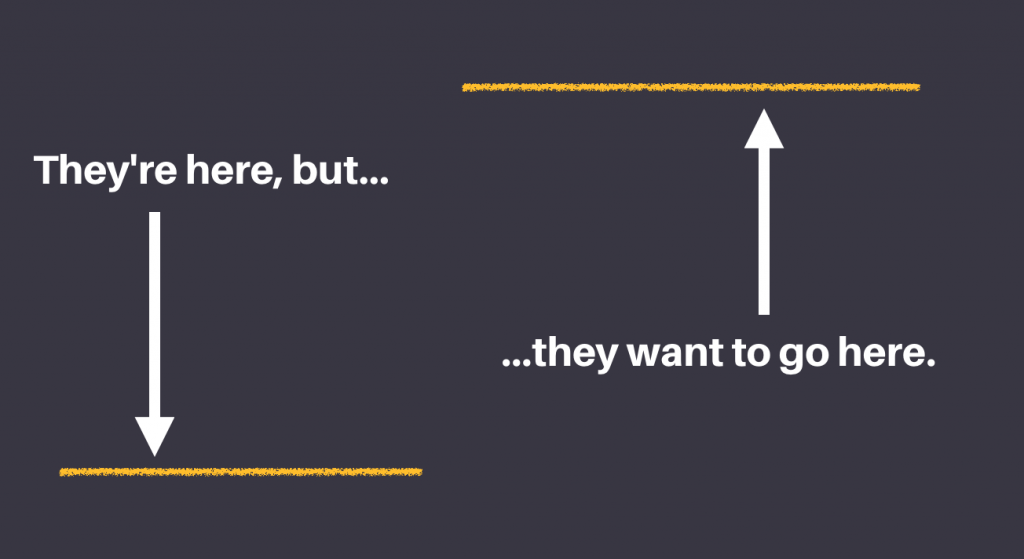
For example, when someone who wants to start a chatbot business opts into Bot Academy’s sequence, we send messages with tips for building bots, getting subscribers, and landing clients.
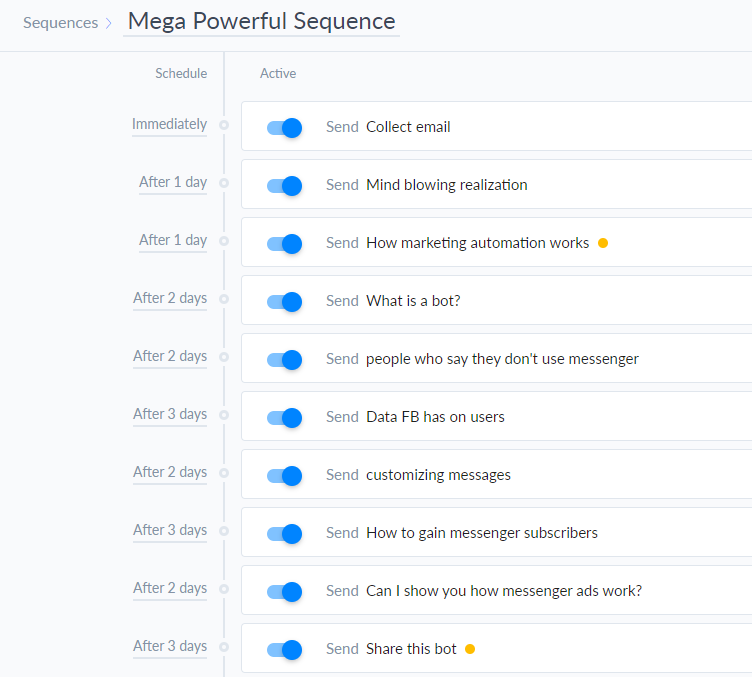
Throughout this process, users will understand who you are, what you offer, and why they should buy. You can then send promotional messages at the end of the sequence once they’re primed and ready to purchase.
2. Get Repeat Engagement
Facebook’s “24+1” rule dictates when you can send subscribers messages based on how recently they engaged with you.
Here’s how the 24+1 rule works.
The “24” part: After someone interacts with your bot, you can message them as much as you want, including promotional messages, within 24 hours (but don’t be a jerk).
The “+1” part: After 24 hours, you get 1 last message.
This was especially helpful when Andrew chatted live with people on a Friday, and went to spend time with his family over the weekend.
On Monday, he saw several people messaged him on Friday night, and the 24 hour period had closed. The +1 part meant he had 1 last chance to respond to them.
The more frequently users engage with your bot, the more opportunities you have to message them.
So how do you get repeat engagement?
-
- Use the comment tool on important posts. This feature allows you to automatically message a user when they comment on a post.
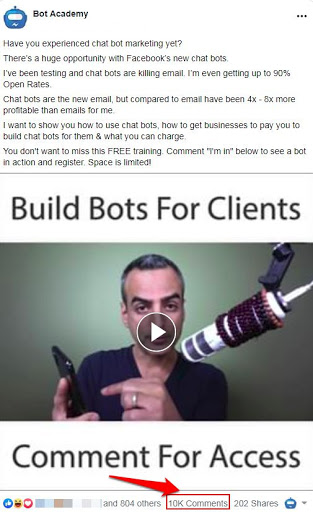
- Use the comment tool on important posts. This feature allows you to automatically message a user when they comment on a post.
You can do this on Facebook lives, link posts, photo posts, etc. and you can even turn it on after a post is already published if you see it’s getting strong engagement.
- Use content upgrades. This is where you deliver a checklist, guide, or other free piece of content via Messenger. Users can opt-in directly on your site using embedded or overlay widgets.
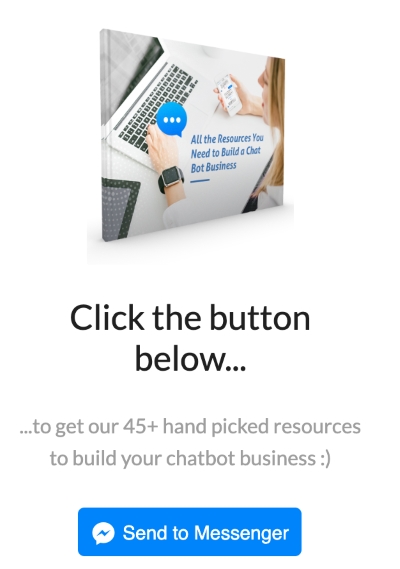
- Use your chatbot as a reminder. For example, when a user registers for a Bot Academy webinar, they can ask to receive a notification when the webinar starts.
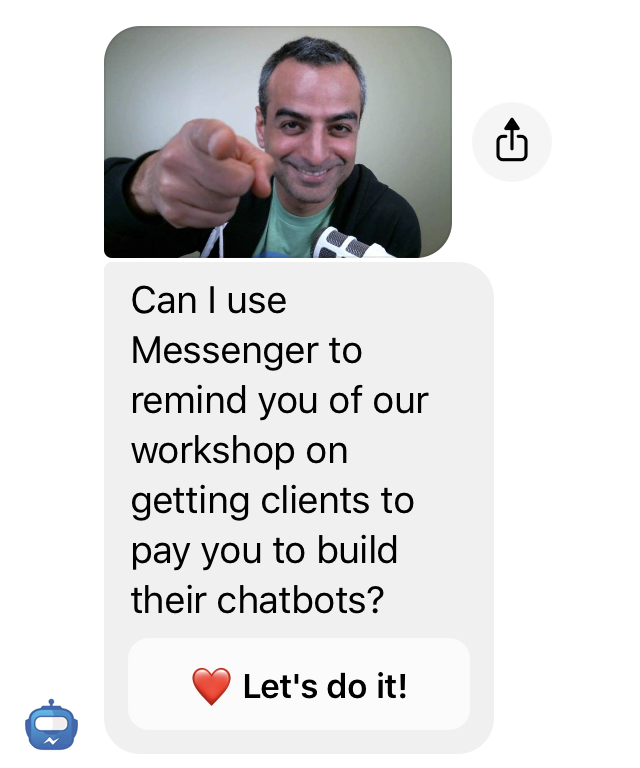
This not only re-opens the 24+1 window, it typically produces higher open and watch rates than email reminders. Here’s a look at our internal stats for comparison.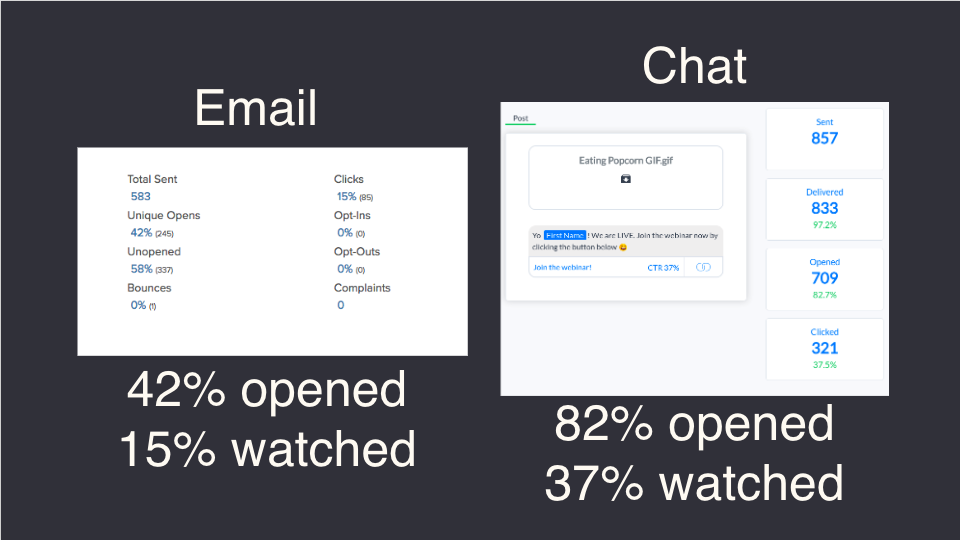
- Use Messenger for live chat. You can do this either on your website or in the Messenger app.We recently shared a case study where Andrew spent over 12 hours live chatting with 300+ people and made 11 sales. If you or your client offer customer service support, chat is the perfect platform to deliver it.We cover even more strategies like this inside Bot Academy, but you get the picture.
3. Go Beyond Marketing
Marketing is where you talk to people until they understand why they should buy from you and then like you enough to buy.
However, you can use chatbots in other phases of the buyer’s journey, including after the sale to drive repeat purchases, loyalty, and customer satisfaction.
Beyond marketing example #1: Receipts
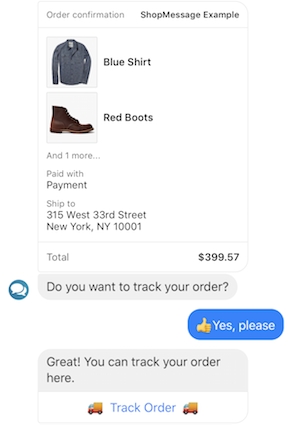
The ShopMessage platform allows you to send receipts via Messenger after someone makes a purchase in your eCommerce store. In the example above, users can also opt-to receive tracking data on their package, and they are offered upgrades and special offers for their next purchase.
Beyond marketing example #2: Chat support
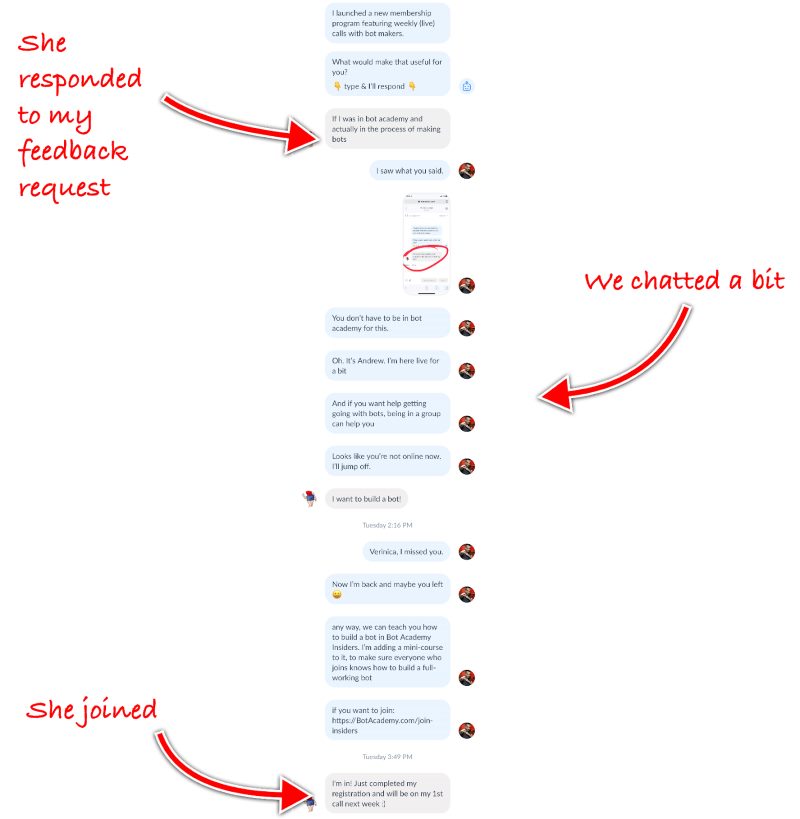
Scroll back above to see how chat can help your users, and allow you to send messages to them.
Beyond marketing example #3: Tracking
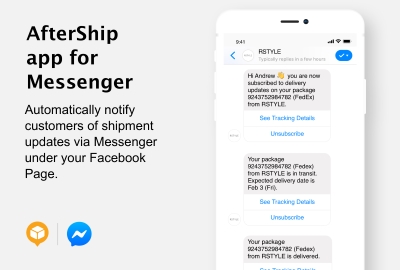
When someone buys a product online, it’s natural to wonder when it will arrive and to want to see where in the world their package is. Facebook has encouraged the use of chat for tracking. AfterShip & other ecommerce apps allow you to automatically send package tracking information to buyers via a chatbot right after they buy.
4. Incentivize Re-engagement
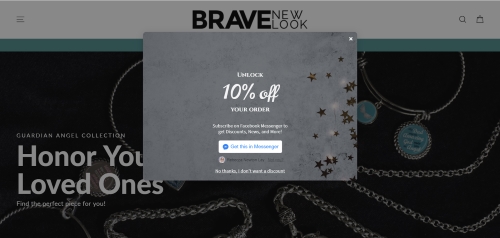
Special offers delivered exclusively via Messenger are another way to drive repeat engagement with your chatbot and re-open the 24+1 window.
You can trigger these offers on specific pages or based on specific actions that signal purchase intent, such as viewing product details or adding a product to the cart without checking out.
Even better, one-click Messenger pop-ups like the one below convert 3X more than email optins.
5. Pay for It
If you absolutely must send promotional content to your subscribers outside of the 24+1 rule, you can always pay to send sponsored messages.
This seems painful if you’ve been sending these broadcasts for free. However, it’s a pretty sweet deal.
Here’s why.
- Sponsored messages are cheap.
We expect Facebook to charge approximately $20 for sending $1,000 sponsored messages. That’s just 2 cents per message.
When you factor in that messages sent through Facebook Messenger can generate 80% open rates with 20% click-through rates, you’re paying about $0.12 per click.
According to Wordstream, the average CPC across industries for Facebook ads is $1.72. That effectively makes sponsored messages 7% of the cost.
- You only pay to sell.
Since you only pay to send promotional messages, there’s built-in ROI from whatever offer you’re promoting.
And even then, you’re only paying for the first message. If they engage with that message, you have 24+1 to send free follow up messages.
You really want to make that first message count, so be sure to make it engaging and use the copywriting strategies we cover inside Bot Academy to grab their attention.
In Summary
Chatbots are still an incredibly valuable marketing tool. This policy update doesn’t change that.
It just means that expertise in how to get real results with chatbots is more valuable than ever. Luckily, that’s exactly what we’ve always taught inside of Bot Academy 😉.
If you held out on joining Bot Academy because you were worried this update meant the death of chatbots, we want to give you a chance to get in now that you have facts. Join our free webinar to discover exactly how to build your first bot and start landing clients.

